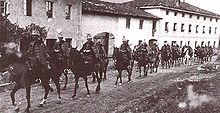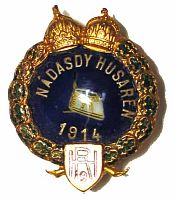Imperial and Royal Hussar Regiment "Graf Nádasdy" No. 9
The hussar regiment "Count Nádasdy" No. 9 was set up as the Austro-Habsburg cavalry association. The unit then existed in the Austro-Hungarian or Joint Army within the Austro-Hungarian Land Forces until it was dissolved in 1918.
When a ranking was drawn up in 1769, the regiment was assigned the ranking designation Cavalry Regiment No. 11 .
In 1888 it was ordered that the regiment should use the name "Count Nádasdy" for all time .
All honorary names of the regiments were deleted without replacement in 1915. From then on the regiment was only to be called "Hussar Regiment No. 9". (However, this could not be enforced in common parlance, on the one hand because nobody adhered to it, on the other hand the thrifty kuk military administration had ordered that all existing stamps and forms be used up first.)
Status and association membership 1914
- V Corps - 10th Cavalry Troop Division - 8th Cavalry Brigade
- Nationalities: 81% Magyars - 19% others
- Uniform: Dark blue Attila with white olives and white shako cover
- Commander: Lieutenant Colonel Alexander Haas
- Regimental language: Hungarian
Establishment
- On 10 December 1688, received generalfeldwachtmeister Graf Czobor of Emperor Leopold I a patent in Upper Hungary two Hussar regiments of 1,000 men to enlist. (Count Czobor had set up the irregular Banderia hussar regiment as early as 1685). For unknown reasons, however, the formation of one regiment was assigned to Colonel Johann Graf Pálffy ab Erdöd, who also became the first owner. It was the imperial army's first regular hussar regiment. (The second regiment, set up by Count Czobor, was given to Colonel Adam Kollonits after his death in 1691. It was disbanded in 1721.)
- 1690 Surplus men and officers taken over by the Deák Hussars regiment .
- In 1700 the regiment was destined for dissolution, but was instead reorganized and left in service.
- 1706 parts of the dissolved hussar regiments Gombos, Czungenberg and Csáky were incorporated
- 1721 The unit is located in a very bad state was with the Hussars Joseph Esterházy merged
- 1731 Auction Company was applied to the Husaren regiments Dessewffy (later no. 3) and Czungenberg (later no. 8) divided
- 1748 a squadron of the Hussar Regiment Trips was incorporated
- 1768 a squadron of the hussar regiment Emerich Esterházy was incorporated
- 1769 The regiment received the ranking list number 11 of the imperial cavalry
- In 1775 the Colonel Division of the Wurmser Hussar Regiment was incorporated
- In 1798 the 3rd Majors Division was transferred to the newly established Hussar Regiment No. 5 . The regiment received the Hussar tribe list number 9
- 1849 After participating in the Hungarian revolt, the regiment was reorganized and rebuilt in Leibnitz in Styria
- In 1860 a squadron formed from the 4th Division, which was to be dissolved, was transferred to the Voluntary Hussar Regiment No. 1
Supplementary districts
- 1781 Veszprém , later Esseg
- 1853 furnace
- 1857–60 Komorn , Neusohl , Ofen
- 1860 Raab and Stuhlweissenburg
- 1867-74 gran
- 1874–89 Komorn and Raab
- From there in the territorial district of Bratislava
Peace garrisons
| I. | II. | III. |
|---|---|---|
|
|
|
Regimental owner
- 1688 Colonel Johann Graf Pálffy from Erdöd (Hussar Regiment Graf Pálffy)
- 1700 Colonel Ladislaus Freiherr Ebergényi (Hussar Regiment Ebergényi)
- 1724 Field Sergeant Georg Emerich Count Csáky de Keresztegh (Hussar Regiment Count Csáky de Keresztegh)
- 1741 Sergeant General Franz Leopold Graf Nádasdy on Fogaras (Hussar Regiment Graf Nádasdy)
- 1783 Lieutenant Field Marshal Johann Nepomuk Count Erdödy de Monyorókerék (Hussar Regiment Count Erdődy de Monyorókerék)
- 1798 Change of name to Hussar Regiment No. 9
- 1806 Major General Johann Maria Philipp Frimont von Palota , Prince of Antrodocco
- 1832 Lieutenant Field Marshal Georg Freiherr von Wieland
- 1833 Nikolaus I. Kaiser v. Russia
- 1849 Lieutenant Field Marshal Franz Prince von und zu Liechtenstein
- 1887 Lieutenant Field Marshal Prince von Thurn und Taxis
Battle calendar
- 1688 Immediately after the formation, the regiment was deployed in Bosnia against the Turks
- 1689 relocation to the Rhine
- 1698 relocation to Hungary. Great losses in a skirmish at Gross-Becskerek
→ War of the Spanish Succession
- 1702 fighting in Italy
- 1706 Battle of Turin
- 1708 Occupation of the Papal States
- 1713 Relocation to the Rhine, patrol and patrol services
→ Venetian-Austrian Turkish War
- 1716–17 battles against the Turks near Peterwardein , Temesvár and Belgrade.
→ War of the Quadruple Alliance
- 1719 fighting in Italy, participation in the siege of Messina . The regiment stayed there until 1734
→ Russian-Austrian Turkish War (1736–1739)
- 1737–39 fighting in Serbia, the Banat and on the Croatian-Turkish border
→ War of the Austrian Succession
- Fighting in Silesia and Bohemia , taking part in the siege of Prague . Battles in the Upper Palatinate . Seconded to the Duke of Lorraine's army on the Rhine, fighting at Halberschwerdt, Reich-Hennersdorf, in the battle of Hohenfriedberg and in Thrush
- 1746 fighting in the Spanish Netherlands in the Netherlands against the French
- 1757–58 battles in Bohemia and Silesia, battle near Kolin , battles near Görlitz and Breslau , battle near Leuthen
- 1759 Battle of Kunersdorf
- 1762 fighting near Burkersdorf and Peilau
→ Russian-Austrian Turkish War (1787–1792)
- 1788 Relocated to the Coburg Corps in the Hungarian-Turkish theater of war. Skirmishes at Botoșani , Larga and Iași and at Mehadia
- 1789 Participation in the siege of Belgrade and Gladova
- 1793 In the army on the Rhine with smaller skirmishes near Offenbach , Ottersheim and Knittelsheim.
- 1796 Relocated to Italy, the regiment led retreat battles at Castiglione and Tarvisio
- 1800 fights in Italy and Tyrol . Battle of Marengo and battles near Valeggio-Pozzolo.
- 1805–13 fighting in Italy
- 1813 Fighting in Inner Austria in the Hermagor district , near St. Georgen and Bruneck . A division detached to Veneto fought with distinction in the skirmish near Castelfranco and Cittadella. Battle at Rezzonico. Here two officers received the Maria Theresa Order
- 1815 Patrol and security services in Italy and France
- 1821 campaign to Naples
→ Revolution of 1848/1849 in the Austrian Empire
- 1848/49 During the revolution of 1848/49 the regiment responded to the appeal of the Hungarian secessionist government and fought against the imperial troops and their allies
- 1864 Battles in the Duchy of Schleswig . The regiment moved to Jutland ago
- In 1866 the regiment fought at Langenbruck , Gitschin , in the battle of Königgrätz , at Hollabrunn and Ulrichskirchen.
→ First World War and whereabouts
During the First World War, the hussars were exposed to a wide variety of uses. At first they fought as cavalry in the regimental unit, but were also used as infantry in all theaters of war. It is currently unknown whether the regiment was deployed as a unit or as a split division cavalry . The status as a cavalry regiment existed until the end of the war.
After the end of the war, the regiment returned from Bulgaria in an orderly manner and was demobilized in Budapest.
structure
In the Austro-Hungarian Cavalry, a regiment usually consisted of three to four (in exceptional cases more) divisions . (A division was used here to refer to a battalion-strength unit. The correct division was called an infantry or cavalry division.) Each division had three squadrons , each of which consisted of two companies . The number of riders in the individual sub-units fluctuated, but was usually around 80 riders per company.
The individual divisions were named after their formal leaders:
- the 1st division was the colonel division
- the 2nd division was the lieutenant colonel (lieutenant colonel) division
- the 3rd division was the majors division
- the 4th division was the 2nd majors division
In the course of the army reform, the cavalry regiments were reduced to two divisions from 1860 onwards.
Until 1798, the regiments were named after their respective owners (who did not also have to be the commanders). There was no binding regulation of the spelling. (e.g. Count Serbelloni regiment - or Serbelloni regiment.) With each change of ownership, the regiment concerned changed its name. After 1798, the numbered designation prevailed, which could possibly be linked to the name of the owner. Due to this constant renaming, the regimental histories of the Austro-Hungarian cavalry are very difficult to follow. In addition, there is the constant and apparently arbitrary, sometimes multiple reclassification of the associations. (For example: Kuk Bohemian Dragoon Regiment "Prince of Windisch-Graetz" No. 14 )
- see: kuk hussars
literature
- Obstlt. Alphons Frhr. v. Wrede: History of the KuK Wehrmacht from 1618 to the end of the XIX century Vienna 1898–1905.
- Georg Schreiber : The emperor's cavalry. Austrian cavalry in 4 centuries. With a foreword by Alois Podhajsky . Speidel, Vienna 1967.
- BM Buchmann: Austria and the Ottoman Empire. WUV-Univ.-Verl., Vienna 1999.
- Allmayer-Beck / Lessing: The K. (below) K. Army 1848–1914 Bertelsmann, Munich 1974.
Footnotes
- ↑ according to “Announcement of the Quartermaster's Department” of Army Group Command FM. Archduke Eugen / Q.Op. No. 665/15. Issued by the field post office 512






